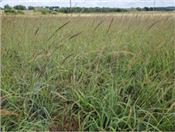Management Of Native Grasses Doesn’t Stop During Winter

Big bluestem/indiangrass mix planted in spring of 2021 going into the first winter.
Image courtesy Dirk Philipp
FAYETTEVILLE, ARK.
For all things, there is a season. For a few things – managing native perennial warm season grasses, for example – there’s every season.
Dirk Philipp, associate professor of animal science for the University of Arkansas System Division of Agriculture, said pasture managers should be honest with themselves: the work to preserve and support those grasses doesn’t go into hibernation mode once the grazing season is done.
“Before and during winter dormancy of these grasses, there are steps that can be taken to ensure lush regrowth the next spring,” Philipp said. For the best results, he recommends growers approach management from three points of view: stand evaluation, winter care and thatch management.
Stand evaluation
“When evaluating your stands, ask yourself: Do you notice any changes in stand density to prior years?” Philipp said. “If you’re not constantly adjusting grazing pressure, duration and frequency based on the situation, you may end up with thinning stands in the long term.”
While the native perennial warm season grasses used today are selected cultivars, they shouldn’t be continuously grazed, Philipp said.
“The danger doesn’t actually stem from grazing too deep into the canopy, but rather, from constantly removing leaf material and depriving the plant from photosynthesis,” he said.
If a grower noticed increased weed intrusion over time, Philipp said, it’s likely a sign of a weakening stand. Broadleaf weeds – the occasional pigweed, for example – aren’t really a problem, Philipp said. But bermudagrass is, especially in native grass stands.
“Bermudagrass is usually shade-sensitive, and native warm season grasses, such as big bluestem, will throw enough shade to keep bermudagrass at bay. In more open canopies, however, bermudagrass will compete well with the native perennials.”
Growers should also have a good grasp of the plant and crown size within their own pastures. Big bluestem and, to a lesser extent, Indiangrass, will develop elevated bunches over time, Philipp said.
“But these grasses have been part of a larger prairie ecosystems, so there is naturally quite a bit of space in between individual plants,” he said. “Growers should note if these crowns become smaller or larger over time.”
Wintertime care
Native perennial warm season grasses should go into the winter with a minimum of 18 inches of canopy height, Philipp said. This not only ensures carbohydrate accumulation before the first frost, but also helps with insulation during the winter, provides wildlife habitat and provides shade for suppressing winter annual weeds.
“During dormancy, the native grasses can be grazed to clean up senesced material, but this should probably wait until late winter before the green-up,” Philipp said.
Thatch Management
Ideally, Philipp said, prairies and grasslands are managed by burning.
If burning isn’t an option, thatch can be bushhogged.
“Make sure to set the bushhog somewhat high, cut evenly and drive slowly to avoid swathing behind the equipment,” he said. “While prairies certainly did not burn every single year, prescribed fire is a valuable management tool for removing the winter thatch, preferably in February.” ∆